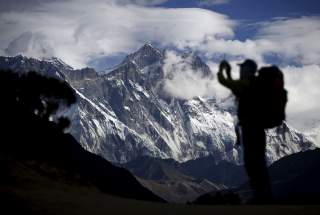Mount Everest: 11 Climbers Dead in 16 Days (What Happens to the Bodies?)
Not an easy question.
Climbing Mount Everest has long been a metaphor for extreme achievement – something that is both hard and hazardous. And, over the years, the bodies of those seasoned Sherpas who perished in accidents or climbers who succumbed to the cold and altitude have testified to just how dangerous it is to attempt to climb to the 8,848-metre summit.
But recent overcrowding has led to a spate of “blue sky” deaths on the mountain. Snaking queues of climbers above 8,000 metres in the oxygen-depleted death zone have been forcing people to spend dangerously long at altitude.
The adventure filmmaker Elia Saikaly described his recent experience on Everest, where at least 11 people died descending from the summit this season:
I cannot believe what I saw up there. Death. Carnage. Chaos. Lineups. Dead bodies on the route and in tents at Camp Four. People who I tried to turn back who ended up dying. People being dragged down. Walking over bodies. Everything you read in the sensational headlines all played out on our summit night.
What, if anything, can be done to ensure that these and past human remains on Everest are treated with dignity and respect – in ways that reflect the wishes of the deceased and their families? And how can we prevent a new wave of deaths during the next summit season?
Dealing with death
Recovering bodies from Everest is extremely difficult – and hugely expensive. High altitudes, strong winds and subzero temperatures make getting up enough of a challenge, let alone freeing and carrying down a newly frozen body. Recovery expeditions risk the lives of the team of courageous Sherpas who brave the mountain again and again.
The more inaccessible corpses from past ascents have remained in limbo for decades, becoming landmark features in the landscape. Their images circulate on social media and are sometimes given nicknames by mountaineers, something that causes significant distress to families and loved ones.
Sometimes religious sensitivities lead to action. After lobbying by families, in 2016 the government of West Bengal paid US$90,000 to recover the bodies of two Bengali climbers, enabling them to be returned for cremation according to Hindu rites.
Western states offer no such support. Expensive insurance plans that cover recovery are often not purchased. Some grieving families request that their loved ones be left united with the mountain that they loved. But as the death toll increases, and climate breakdown reveals more and more bodies from past improvised disposals down the steepest faces of Everest into the glacial basins below, new approaches are required.
The Chinese and Nepalese authorities have different ways of managing the mountain. On the Tibetan side, the Chinese mountaineering authorities only allow experienced climbers to ascend. They have also been known to clear bodies from the north-east ridge in an effort to clean up the image of commercial mountaineering in Chinese-occupied Tibet.
Nepal is less tightly regulated, leading to cut-price expeditions and overcrowding. In the absence of proficiency checks, the country attracts inexperienced climbers seduced by the social status of reaching the summit of Everest. They risk not only their own lives, but those of others too. Inevitably, more people are currently dying on the Nepalese side of Everest.
The Nepalese authorities have begun to coordinate annual clean up expeditions to remove litter from the mountain, which frequently bring down human remains in the process. However, they often lack the means to identify them – and there is no clear indication that they are disposed of in culturally appropriate ways.
The governing body of the world’s mountaineering associations, the International Climbing and Mountaineering Federation (UIAA), urgently needs to bring together all stakeholders in Everest’s future. Engaging in dialogue with Chinese state agencies on activities in occupied Tibet is complicated, but the UIAA could assist the Nepalese state in tightening regulation and implementing proficiency tests for prospective climbers to tackle the overcrowding that will otherwise risk further deaths next season.
Agencies such as the International Committee of the Red Cross and the International Commission on Missing Persons should also be invited to share their experience with local NGOs and state agencies to improve methods of locating and identifying human remains as well as the recording of their removal and disposal, and the notification of next of kin.
Finally, the UIAA needs to develop a values-based code of ethics for the mountain that would bring together not only the above parties, but also the insurance industry, adventure travel companies and – most importantly – the Sherpa community. The aim must be to develop a shared understanding of how to look after the mountain and its climbers.
As the labour force on the front line of dealing with human remains on the mountain, the Sherpa community should be central to this process. Here, the UIAA should look to existing successful models that prioritise indigenous rights, such as the San Code of Ethics. After decades of invasive and exploitative research into their genes and culture, the hunter-gatherer San people of southern Africa developed this ethical framework with an NGO to ensure that research is mutually beneficial and conducted in line with San values.
There are no easy solutions to the bodies on Everest, nor the deaths that precede them. But anything other than urgent change will disfigure the mountain and seriously damage commercial mountaineering’s reputation for good stewardship. Indifference is not an option.
This article by Jonathan Westaway first appeared in 2019 in The Conversation via Creative Commons License.
Image: Reuters.

